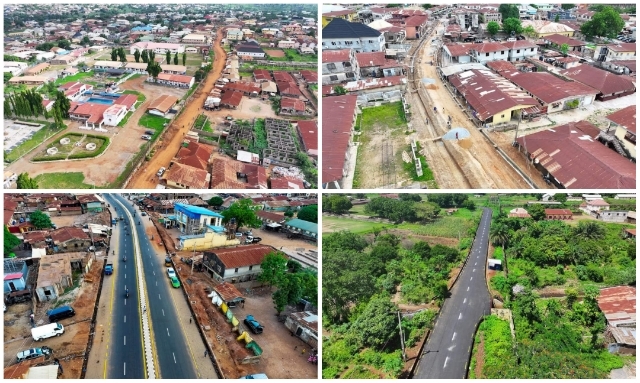
The buzz statement in Ilorin today is urban renewal. The indicators are becoming a dominant point of discussion in the city, on social media platforms, as well as in political society. Those who oppose what’s becoming a very notable expression of public policy describe it in very negative frames and strongly politicize it. It shouldn’t be a surprise at all.
I spent the week from Wednesday, June 26th, 2024, to Tuesday, July 2nd, in Ilorin. On arrival, I saw indicators of what I’d read about and been told in conversations in the days before I got in. So, on Thursday night, between 10pm and 0230 am, Nurudeen Abdulrahim drove me around Ilorin. We left my area of the GRA and drove on the Ahmadu Bello Way, and I noticed that shops that, for many years, had illegally eaten up the road setback from opposite Kwara Hotel right up to the Challenge Bookshop end, had been removed.
We then turned into the Murtala Muhammed Way, towards the post office, and by the side of the road as one turned towards the Zulu-Gambari Road on the side of the Kwara State Library, the various shacks that had eaten into the thorough fare and which made movement in that part of the city truly difficult, had similarly been cleared. We went further onto the same road where it joined the Ahmadu Bello Way, and I noticed that Kaosara Pharmacy and the adjoining shops, were no longer there. Now, it was possible to discover that there used to be a wall around the government offices in that part of Ilorin.
We were not done. We returned to the post office area, and under the flyover, at that time of night, there were a few officers of the Nigerian Civil Defence Corps on duty. They assured me that the owners of the shops and shacks were clearing off their wares because they had been given a timeline for clearance of their stuff.
We drove on Emir’s Road, passing the old Midland Stores and what used to be Gaskiya Bookshop, and I noticed that the buildings that for long had been covered by different types of shops had become visible again, and as we crossed the bridge on the Asa River, we noticed that the same trend was unfolding. People are clearing their wares, and we drove towards Balogun Fulani, joined the road to Gambari, Ita Ajia, and up to the frontage of Magaji Abudu’s residence.
This was already way past midnight, so there were no market men and women, and there was an eerie silence, but the area was as dirty as ever! And if ever there was an area of Ilorin that will signpost the success or failure of the urban renewal process, certainly it is this location of Ilorin.
A flashback is appropriate here. Colonel George Agbazika Innih became the military governor of Kwara State, following the tragic coup of February 13th, 1976, which saw not just the assassination of the Head of State, General Murtala Muhammed; in Kwara State, the beloved governor, Colonel Ibrahim Taiwo, was also killed. Governor Innih had promised to work with commitment and he did, going on a construction spree that has continued to be remembered till today.
Governor Innih relocated the old Eid Praying Ground from the smaller location on what became Unity Road, that was increasingly becoming an important commercial artery of the city, to a much larger, expansive location on a road that was opened up as a mixed development zone of residential, commercial, educational, and industrial area. The old Eid praying ground became the Ilorin Anusement Park. It had a mini-zoo; a remembrance arcade; seating areas for families and children; a generous area for food and drinks; and impressive greenery which was a most beautiful setting for relaxation. It would eventually deteriorate and became a point of controversy, in later years.
Governor Innih wanted to clear the market area around the Emir’s Palace and to achieve that, he constructed the Baboko Market for the relocation of those who were around the palace. Up till today, there’s been a stubborn refusal to move, and as the years have passed, so has the depth of chaos in that location of the city.
The shops have completely eaten up the road; so if one approached from the Oniyangi family house and up to Magaji Muse towards the old Palace Cinema, Origun Nda, right up to the mosque, and towards the junction going to Isale Oja and further on towards the residence of the Daudu and the junction going to Pakata, the anarchy is total: people selling provisions, meat, vegetables, second hand clothes, shoppers from all parts of the city, the Keke, the buses, that stop at any and every point, police officers, ostensibly there to control traffic but more interested in what could be extracted from the lawlessness and anarchy of that part of the city!
I have effectively been living out of Ilorin since 2002, when I resigned my appointment as pioneer GM of KWTV, to start a new life as pioneer Editor of Daily Trust in Abuja. Over these 22 years, I’ve returned home regularly to experience the increasingly dysfunctional nature of the city. Traffic logjam and the unregulated construction of stalls, shops, and shacks, all make movement a nightmare.
People carry on without any care for the basic norms of modernity, and the structures of development control are either non-existent, inefficient, or absolutely corrupted. As the city has grown, sucking in more people from outlying parts of the state, and from other parts of the country, it is becoming unlivable because the ethos of modernity and the discipline associated with urban culture are just not present.
The unregulated development, the tendency to appropriate road setbacks for commercial use, the narrowing of thorough fares, the takeover of these roads by unruly bus drivers, Keke operators, motorcycle taxis (Okada), and sundry urban lumpens, all deepen the crisis of urban life, and add to the generally inefficient use of city amenities, and these in the long run, devalue the lives of the citizens.
On the second day, Saturday, we drove through the Oja-Oba market, and it was clear that it is what the urban renewal makes of that location, that could eventually make or mar the process. While to the left side, the palace wall that had been covered by shacks and stalls for a long time, was now visible again, with the clearances done there. Nevertheless, from the junction towards the Gambari Quarters, through the frontage of the Magaji Abudu residence and up to the turn towards Agbarere to go to Oloje, the old problem has persisted.
The stalls and sellers were right on the road; pedestrians were having a problem moving between the displayed wares, the wrongly parked buses and Keke; the traffic policemen seemed helpless or taking advantage of the mayhem that enveloped them, and everyone caught up in the attempt to pass through.
At Oloje, we discovered that the wall of Mount Carmel College was finally visible again, after it had been swallowed up for years, by the shops that also made traffic in that neighborhood very difficult. As we drove towards Tegbesun, we made a turn towards the Federal Housing Estate, and through that came out at Adeta roundabout unto Al-Hikma University and the Western Reservoir Road, leading to the Mandate Market.
There also, the market folk refused to use the open and lockup shops that they have inside; they preferred to display their wares by the roadsides, narrowing the road, and consequently, affecting the flow of traffic. We then drove back to Ibrahim Taiwo Road to inspect what had been done around United School, which had also been completely lost to the shops on both sides of the school, on Ibrahim Taiwo and Unity Roads. It was heartwarming to discover that my old primary school could finally breath again! The work done on Unity Road, in my opinion, validates why we must persist with the urban renewal process in Ilorin.
Let’s be clear about it. Urban renewal is often a very painful process because there are those who would lose. Those whose lives have been constructed around the illegal takeover of urban spaces; the owners of the shacks, stalls, and shops; the petty traders who eke out a livelihood on a daily basis, often able to take advantage of traffic logjam. Then there are the powerful interests who often have the ability to intimidate even the state.
On the other hand, there’s also the force of habit, with people used to living amidst the chaos of daily existence that they assume to be the normal. There’s the fear of the unknown, as well as the fact that for too long, nothing was done to correct the rot and therefore, people believe it was impossible to do anything to the contrary.
It is therefore vital to keep eyes on the ball and see through the process. The lesson from Kaduna, one of the three cities that I live in, is that a lot of people, at the beginning, feel tremendous hostility to urban renewal projects. But, in the long run, when they see how much the process changes their ways for the better, they begin to appreciate the new and even want more!
The urban renewal process in Ilorin can find the same levels of success especially if the project is properly communicated ti the people. Nothing beats communication! Similarly, there should be legal backing for the process so that people can always be referred to law, if there is the danger of relapse. The regulatory bodies must be backed to esforcé development control in the city while municipal governance should become genuinely responsive and responsible to deepen the process.
It is also imporyant to regulate the use of motorcycle taxis (Okada) and Keke within the metropolis. Government should work with the relevant unions to work out allotment of routes for these operatives. The anarchic and unregulated movement of motorcycle taxis in every part of the city isn’t good for security and law enforcement. A very important element of urban renewal is to install CCTV cameras all over the city to assist in crime control. This is doable!
Of course, there are those whose livelihoods must have suffered, maybe even in an irreparable manner, as a result of the process underway. I’m wondering if a census of the owners of the stalls had been carried out in order to work out some compensation for them. That would at least have gone some way to ease the pain they have earned from urban renewal.
On a final note, we should embrace modernity, and living in more ordered, better organised urban settings. Such a livelihood pattern has its own rules. We cannot romanticize the anarchic, unhealthy, and disorganized way that we have used the urban space for so long. The changes taking place in Ilorin at the moment certainly carry some pains, but that is the nature of all urban renewal experiences. In the long run, the gains will trump the pains.
- Is’haq Modibbo Kawu, PhD, FNGE; is a Broadcaster, Journalist, and a Political Scientist.([email protected])


